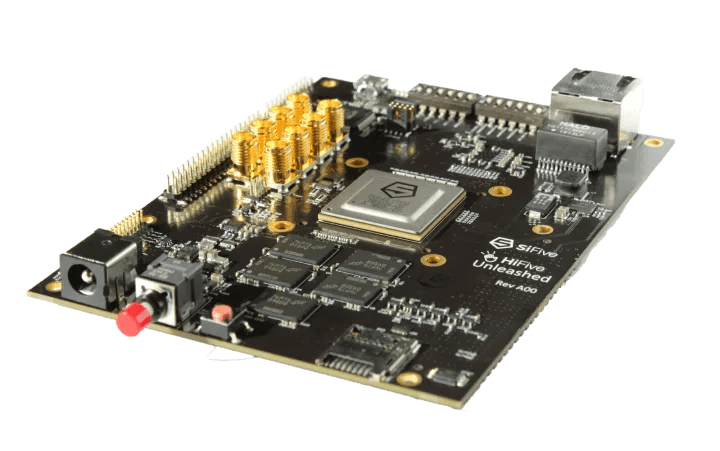Edoardo Barbieri
on 7 March 2022

One could aptly name this February State of IoT as the State of Silicon. With the much-anticipated partnership between ARM and NVIDIA halting to a grind, Intel grabbed this month’s headlines by investing in the open RISC-V architecture and announcing a new fund promoting disruptive startups. Let’s dive straight in!
Ferrari partners with Qualcomm
Software is reshaping the world of automotive. Software-defined vehicles nowadays update their functionalities through over-the-air (OTA) software updates.
Those updates are transactional for reliability and with deltas to minimize network traffic.
Early in February, Ferrari announced a compelling partnership with Qualcomm. Qualcomm, the publisher of the popular DragonBoard 410c Development Board and one of the silicon leaders, aims to usher the ongoing digital transformation in automotive. Their Snapdragon Digital Chassis is certain to play a key role in underpinning the connected car of the coming decades.

Partnering with Qualcomm, Ferrari vowed to start exploring digital cockpit solutions for rich graphics and an immersive infotainment experience.
Intel invests in Risc-V
In the past decade, open-source and open standards have reshaped the world of technology and produced long-lasting results. RISC-V is a new paradigm for Open Source hardware, developing a free and open Instruction Set Architecture (ISA). The ISA holds the promise of increasingly rapid processor innovation through open standard collaboration.
Thanks to its availability on a wide range of processors, from low-end microcontrollers to high-end server-grade processors, RISC-V is empowering a new era of processor innovation with rapid industry-wide adoption. Combining the best open-source architecture with the best open-source operating system, porting Ubuntu on RISC-V further facilitates the adoption of novel computing architectures.

Intel investment in RISC-V was one of the most intriguing headlines of last February. As part of a vibrant ecosystem driving innovation at the edge, Intel and its IoT technology partners work together to promote the deployment of high-performance devices. As Ubuntu optimised for Intel processors is already accelerating the adoption of IoT innovations, Intel’s support for the RISC-V ISA is a strong indication of its commitment to continued investments in open standards and collaboration.
Intel sets up $1 billion fund
Confirming its presence at the cutting-edge of innovation, this February Intel announced a new $1 billion fund to aid “companies building disruptive technologies “.
The vision for the fund is to accelerate Intel Foundry customers’ time to market and facilitate the adoption of modular design approaches spanning toolchains and innovative chip architectures. Among the support for the “full spectrum of chip architectures”, the press release mentioned x86, Arm and RISC-V. SiFive, the commercial entity behind RISC-V, also announced support for Intel’s fund, aiming to extend its open-standard mandate.
The collaboration is broader than a close partnership between Intel and SiFive, as it embraces several players in the ecosystem. Esperanto Technologies develops energy-efficient AI acceleration solutions on top of the RISC-V ISA. The company partnered with Intel Foundry Services to advance massively-parallel 64-bit RISC-V-based AI/ML workloads. Similarly, Ventana Micro provides high-performance chiplets and early this month announced a strategic partnership with Intel for broader commercialisation of its RISC-V cores.
NVIDIA-ARM deal collapses
News from the silicon world dominated the IoT landscape in February. NVIDIA’s acquisition of Arm, announced in September 2020, was expected to reshape trillion-dollar industries and thrust innovations across the compute spectrum.
NVIDIA invented the GPU in 1999, ushering the growth of parallel computing for the decades to follow. Arm is at the forefront of computing, powering billions of devices and arguably the most relevant CPU architecture of the upcoming years.
The transaction would have placed both parties at the heart of global leadership across a spectrum of state-of-the-art tech stacks. The aim of creating the world’s premier computing company for the age of the internet of things and tightly embedded, connected devices fell through this February. The two partners decided to conclude the Agreement because of “significant regulatory challenges” discouraging the fulfilment of the deal. Arm will now commence preparations for listing on the Nasdaq.
AMD acquires Xilinx
While one transaction terminated among regulatory challenges, another industry-shaking acquisition went through. Announced in October 2020, AMD’s acquisition of Xilinx poses them as the leading high-performance and adaptive computing company in the industry. AMD completed its acquisition in February 2022, broadening its spectrum of products, including CPUs, GPUs, FPGAs, and Adaptive SoCs.
Xilinx, now the Adaptive and Embedded Computing Group under AMD, is the inventor of the latter two adaptive processing platforms. AMD, on the other hand, is now expected to capitalize on a TAM of approximately $135 billion in 2023.

Alder Lake N specs revealed
If you are familiar with Intel Alder Lake processors, low-power and low-cost may make you think of ultra-thin laptops. Energy efficiency matters also for constrained boards where the per-device fee is a serious concern. Many factors, from flash storage to DRAM, mandate manufacturers to be the smallest possible when operating at the low-end of the IoT spectrum. What concerns those producers is how to get the cheapest hardware to place it competitively in the market, and the per-device fee is often crucial in the conversation.
The news that Intel Alder-Lake N will feature energy-efficient Gracemont cores rapidly spread across the embedded world.
By analysing commits related to Alder Lake-N and boot logs in the SOF Project, one can expect Intel’s upcoming processors to include an integrated GPU with 32 execution units, PCIe interfaces and LPDRR5 memory support.
Arguably, the Gracemont cores with Intel UHD Gen12 graphics will result in optimized performance compared to Elkhart Lake and Jasper Lake processors. Although Intel has neither unveiled Alder Lake-N nor argued its market positioning, the new processors family is foreseen to power embedded systems for some years to come.
Stay tuned for more IoT news
We will soon be back with next month’s summary of IoT news. Thanks for reading!
In case you missed it, here is a recap of IoT news from last January. Make sure to check it out!
Further reading
Searching for a short primer on embedded Linux? Look no further than this blog post.
Why is Linux the OS of choice for embedded systems? Find out with the ultimate guide to Linux for embedded applications.
In this exclusive webinar, you will learn more about the embedded landscape, the IoT and how Ubuntu Core is raising the bar for embedded Linux.
Want to learn more about the difference between real-time and embedded Linux? Dive into the mini-series on the low latency Linux kernel.



